陕西省山阳县色河中学初中英语《lesson 21 fun at the zoo》课件 人教新目标版
- 格式:ppt
- 大小:1.42 MB
- 文档页数:4
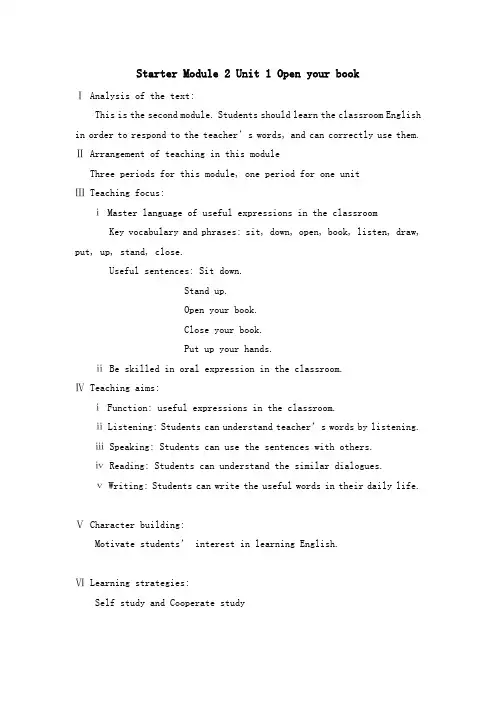
Starter Module 2 Unit 1 Open your bookⅠ Analysis of the text:This is the second module. Students should learn the classroom English in order to respond to the teacher’s words, and can correctly use them.Ⅱ Arrangement of teaching in this moduleThree periods for this module, one period for one unitⅢ Teaching focus:ⅰ Master language of useful expressions in the classroom Key vocabulary and phrases: sit, down, open, book, listen, draw, put, up, stand, close.Useful sentences: Sit down.Stand up.Open your book.Close your book.Put up your hands.ⅱ Be skilled in oral expression in the classroom.Ⅳ Teaching aims:ⅰ Function: useful expressions in the classroom.ⅱ Listening: Students can understand teacher’s words by listening.ⅲ Speaking: Students can use the sentences with others.ⅳ Reading: Students can understand the similar dialogues.ⅴ Writing: Students can write the useful words in their daily life.Ⅴ Character building:Motivate stude nts’ interest in learning English.Ⅵ Learning strategies:Self study and Cooperate studyVII Teaching Procedures:Part I: Lead in:Step 1: Greeting with the students.Step 2: Use the classroom English in the class .Part II: Vocabulary study:Step 1: Play the recording and have them point out the words and phrases in Activity 2.Step 2: Play the recording again and have them read after the tape.Step 3: Have the students match the phrases and pictures in PPT.Step 4: Have the students match the phrases and pictures in Activity 4 and check their answer with their partner.Part Ⅲ: Dialogue study:Step 1: Practice the dialogue with the whole class and have them make corresponding reacts.Step 2: Have students to practice the previous dialogue with their partner.Step 3: Work in pairs and do the Activity 2.Step 4: Work in pairs and practice the dialogue in Activity 2. Have some of them to perform their dialogue for the whole class.。
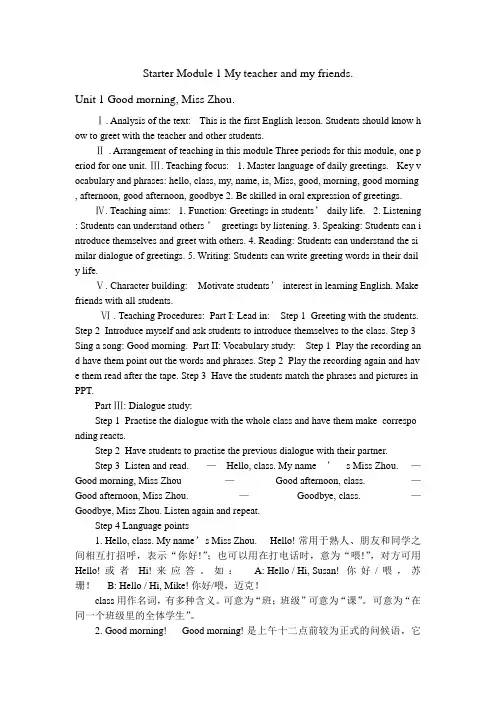
Starter Module 1 My teacher and my friends.Unit 1 Good morning, Miss Zhou.Ⅰ. Analysis of the text: This is the first English lesson. Students should know h ow to greet with the teacher and other students.Ⅱ. Arrangement of teaching in this module Three periods for this module, one p eriod for one unit. Ⅲ. Teaching focus: 1. Master language of daily greetings. Key v ocabulary and phrases: hello, class, my, name, is, Miss, good, morning, good morning , afternoon, good afternoon, goodbye 2. Be skilled in oral expression of greetings.Ⅳ. Teaching aims: 1. Function: Greetings in students’ daily life. 2. Listening : Students can understand others’ greetings by listening. 3. Speaking: Students can i ntroduce themselves and greet with others. 4. Reading: Students can understand the si milar dialogue of greetings. 5. Writing: Students can write greeting words in their dail y life.Ⅴ. Character building: Motivate students’ interest in learning English. Make friends with all students.Ⅵ. Teaching Procedures: Part I: Lead in: Step 1 Greeting with the students. Step 2 Introduce myself and ask students to introduce themselves to the class. Step 3 Sing a song: Good morning. Part II: V ocabulary study: Step 1 Play the recording and have them point out the words and phrases. Step 2 Play the recording again and have them read after the tape. Step 3 Have the students match the phrases and pictures in PPT.Part Ⅲ: Dialogue study:Step 1 Practise the dialogue with the whole class and have them make correspo nding reacts.Step 2 Have students to practise the previous dialogue with their partner.Step 3 Listen and read. —Hello, class. My name’s Miss Zhou. —Good morning, Miss Zhou —Good afternoon, class. —Good afternoon, Miss Zhou. —Goodbye, class. —Goodbye, Miss Zhou. Listen again and repeat.Step 4 Language points1. Hello, class. My name’s Miss Zhou. Hello! 常用于熟人、朋友和同学之间相互打招呼,表示“你好!”;也可以用在打电话时,意为“喂!”,对方可用Hello!或者Hi!来应答。
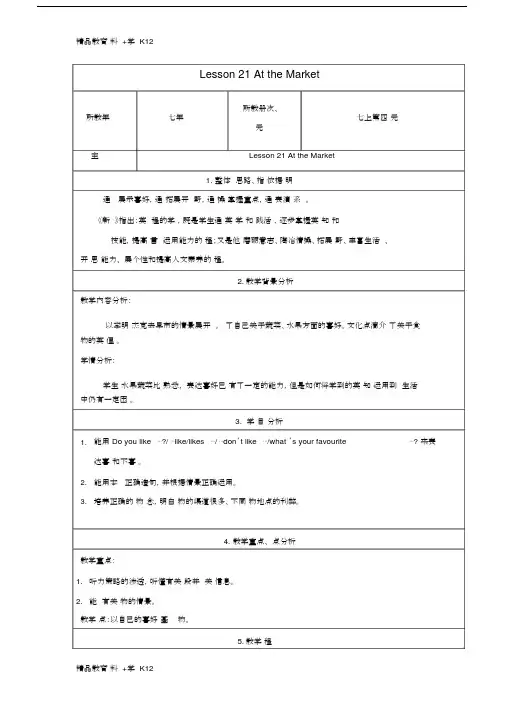
精品教育料 +学 K12Lesson 21 At the Market所教册次、所教年七年七上第四元元主Lesson 21 At the Market1.整体思路、指依据明通展示喜好,通拓展开野,通操掌握重点,通表演系。
《新》指出:英程的学,既是学生通英学和践活,逐步掌握英知和技能,提高言运用能力的程;又是他磨砺意志、陶冶情操、拓展野、丰富生活、开思能力、展个性和提高人文素养的程。
2.教学背景分析教学内容分析:以李明杰克去早市的情景展开。
了自己关于蔬菜、水果方面的喜好。
文化点滴介了关于食物的英俚。
学情分析:学生水果蔬菜比熟悉,表达喜好已有了一定的能力,但是如何将学到的英知运用到生活中仍有一定困。
3. 学目分析1.能用 Do you like ⋯?/ ⋯like/likes ⋯/ ⋯don’t like ⋯/what ’s your favourite⋯? 来表达喜和不喜。
2.能用本正确造句,并根据情景正确运用。
3.培养正确的物念,明白物的渠道很多、不同物地点的利弊。
4.教学重点、点分析教学重点:1.听力策略的渗透,听懂有关段并关信息。
2.能有关物的情景。
教学点:以自己的喜好基物。
5.教学程步骤 1:Warm upHave a free talk with the students, then teach them the new words and expressions.设计意图:通过聊天使学生以愉快、放松的心情投入本节课的英语学习,吸引学生的注意力,激发他们的好奇心,同时巧妙地引出本课生词。
步骤 2:出示学习目标。
设计意图:做到有的放矢,清楚本节课要完成的任务和途经。
步骤 3:Brainstorm: Where can we buy things?supermarket, shopping centre, shopping mall, market, morning market, evening market,department store, store, shop, grocery store设计意图:通过头脑风暴让学生了解购物的渠道,联系生活,引人入胜。
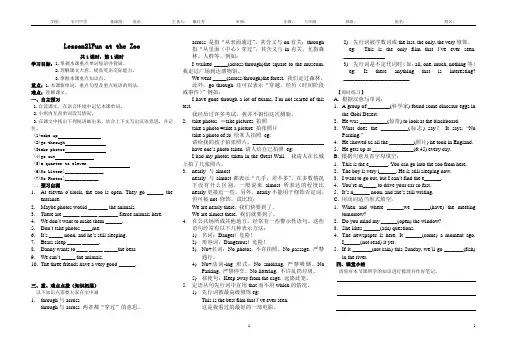
学校: 石川中学 备课组: 英语 主备人: 康红芳 审核: 年级: 八年级 班级: 组名: 姓名:11Lesson21Fun at the Zoo共1课时,第1课时学习目标:1.掌握本课重点单词短语并背诵。
2.理解课文大意,提高英语交际能力。
3.掌握本课重点知识点。
重点:1.本课新单词、重点句型及重点短语的用法。
难点:理解课文。
一、自主预习1.自读课文,在语言环境中记忆本课单词。
2.小组内互查单词读写情况。
3.在课文中找出下列短语画出来,结合上下文写出汉语意思,并记住。
(1)wake up (2)go through (3take photos (4)go out(5)a quarter to eleven (6)No Litter!________________ (7)No Photos!______________ 二、预习自测1. At eleven o ’clock, the zoo is open. They go ______ theentrance.2. Maybe photos would _______ the animals.3. There are ______ ______ _______ fierce animals here.4. We don ’t want to make them ______.5. Don ’t take photos ____me.6. It ’s _____ noon, and he ’s still sleeping.7. Bears sleep _____ ______.8. Danny wants to ____ _____ _____the bear. 9. We can ’t _____ the animals.10. The three friends have a very good ______.三、重、难点点拨(知识拓展) 以下知识点需要大家在文中画1. through 与acrossthrough 与across 两者都“穿过”的意思。

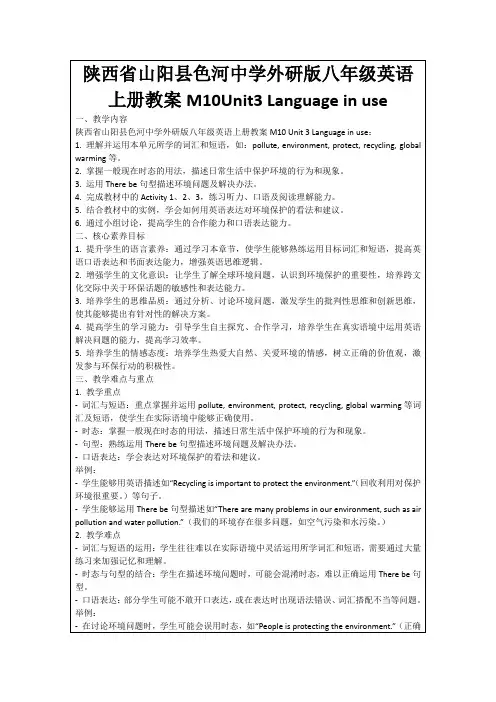
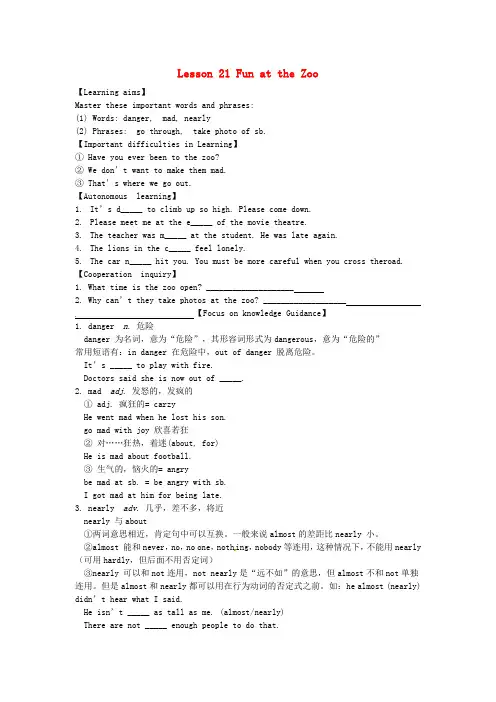
Lesson 21 Fun at the Zoo【Learning aims】Master these important words and phrases:(1) Words: danger, mad, nearly(2) Phrases: go through, take photo of sb.【Important difficulties in Learning】① Have you ever been to the zoo?② We don’t want to make them mad.③That’s where we go out.【Autonomous learning】1.It’s d_____ to climb up so high. Please come down.2.Please meet me at the e_____ of the movie theatre.3.The teacher was m_____ at the student. He was late again.4.The lions in the c_____ feel lonely.5.The car n_____ hit you. You must be more careful when you cross theroad. 【Cooperation inquiry】1. What time is the zoo open? ____________________2. Why can’t they take photos at the zoo? ___________________【Focus on knowledge Guidance】1. danger n.危险danger 为名词,意为“危险”,其形容词形式为dangerous,意为“危险的”常用短语有:in danger 在危险中,out of danger 脱离危险。

七年级下册lesson21知识点本文将会介绍七年级下册lesson21的知识点,这一章主要介绍动词的时态和语态。
对于初学者来说,这是一个特别重要和基础的章节。
一、时态英语的时态主要分为现在时、过去时和将来时。
其中,每个时态又分为简单式、进行式和完成式。
1. 现在时态现在时态表示目前正在进行的动作、经常发生的事情以及客观存在的状态等。
我们可以通过简单式、进行式和完成式来表达。
例如:简单式:I study English every day. 我每天学英语。
进行式:He is playing football now. 他正在踢足球。
完成式:We haven't finished our homework yet. 我们还没完成作业。
2. 过去时态过去时态表示已经发生或完成的动作和状态。
同样地,过去时态也可以通过简单式、进行式和完成式来表达。
例如:简单式:I went to Beijing last week. 我上周去了北京。
进行式:She was sleeping when I called her. 我给她打电话时她正在睡觉。
完成式:They had finished their work by 9 o'clock. 他们在9点之前完成了工作。
3. 将来时态将来时态表示将要发生的动作和状态。
同样地,将来时态也可以通过简单式、进行式和完成式来表达。
例如:简单式:They will leave for Shanghai tomorrow. 他们明天将会去上海。
进行式:I will be having a meeting at 2 o'clock this afternoon. 我今天下午两点将会开会。
完成式:By next year, I will have learned English for ten years. 到明年为止,我将会学英语十年了。
二、语态英语中的语态主要分为主动语态和被动语态。
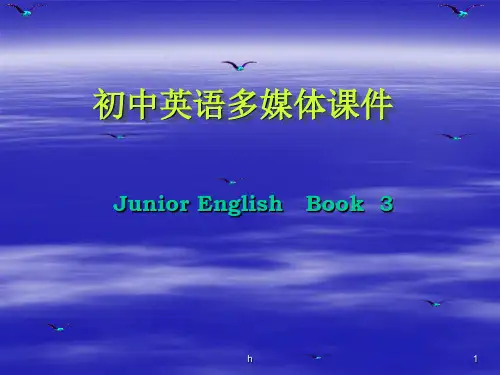
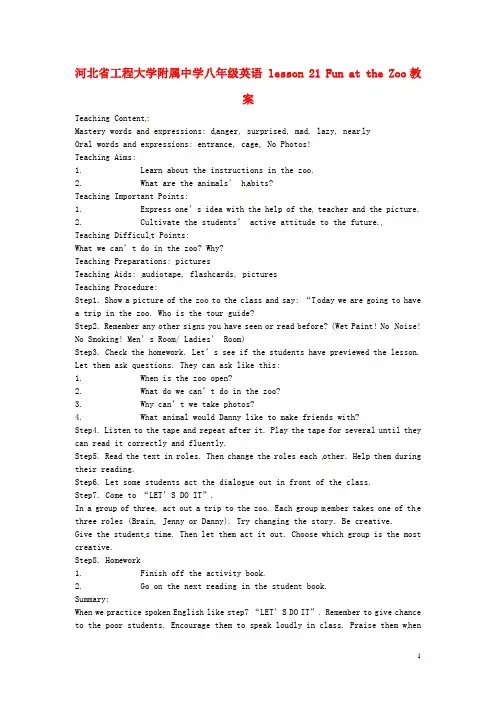
河北省工程大学附属中学八年级英语 lesson 21 Fun at the Zoo教案Teaching Content:Mastery words and expressions: d anger, surprised, mad, lazy, near lyOral words and expressions: entrance, cage, No Photos!Teaching Aims:1. Learn about the instructions in the zoo.2. What are the animals’ h abits?Teaching Important Points:1. Express one’s idea with the help of the teacher and the picture.2. Cultivate the students’ active attitude to the future.Teaching Difficul t Points:What we can’t do in the zoo? Why?Teaching Preparations: picturesTeaching Aids: audiotape, flashcards, picturesTeaching Procedure:Step1. Show a picture of the zoo to the class and say: “T oday we are going to have a trip in the zoo. Who is the tour guide?Step2. Remember any other signs you have seen or read before? (Wet Paint! No Noise! No Smoking! Men’s Room/ Ladies’ Room)Step3. Check the homework. Let’s see if the students have previewed the lesson. Let them ask questions. They can ask like this:1. When is the zoo open?2. What do we can’t do in the zoo?3. Why can’t we take photos?4. What animal would Danny like to make friends with?Step4. Listen to the tape and repeat after it. Play the tape for several until they can read it correctly and fluently.Step5. Read the text in roles. Then change the roles each other. Help them during their reading.Step6. Let some students act the dialogue out in front of the class.Step7. Come to “LET’S DO IT”.In a group of three, act out a trip to the zoo. Each group m ember takes one of th e three roles (Brain, Jenny or Danny). Try changing the story. Be creative.Give the student s time. Then let them act it out. Choose which group is the most creative.Step8. Homework1. Finish off the activity book.2. Go on the next reading in the student book.Summary:When we practice spoken English like step7 “LET’S DO IT”. Remember to give chance to the poor students. Encourage them to speak loudly in class. Praise them w henthey have some progress. Encourage others to help them in many ways to cultivate their confidence。
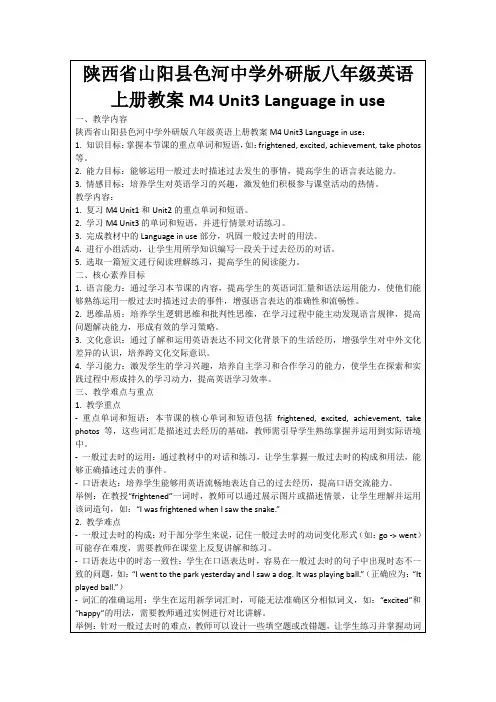
七年级英语Lesson 21—Lesson 24某某+加拿大【同步教育信息】一. 本周教学内容:Lesson 21LiMing’s Letter本课主要学习如何用英语写信1. See you soon 回头见soon 副词, 不久常用于将来时They will e soon 他们不久将要来Spring will e soon 春天不久就要到了See you soon = See you later.2. It’s bigger than Shijiazhuang. 它比某某大big形容词bigger 是比较级。
双写“g”加“er”. 类似的还有red→redder hot→hotter fat→fatter3. At the post office 在邮局post 动词,邮寄名词,I want to post a letter to my father. (动词)我想寄封信给父亲。
There is a post office near my school. (名词)我们学校附近有一家邮局。
4. How much is the stamp?这X邮票多少钱?how much 这里是对价格的提问。
How much are your shoes? 你的鞋多少钱?How much is your new watch? 你的新手表多少钱?此外how much 还可以对不可数的数量、重量提问,对可数名词用how many How much water do you want? 你要多少水?How much money do you have? 你有多少钱?How many people are there in your class? 你们班有多少人?How many pens do you have? 你有几支钢笔?5. 同义词辨析fast,quickly ,soona. fast 快地,指运动的速度快The train runs so fast 火车开得很快b. quickly 快地,迅速地,强调立刻行动,一点也不耽搁e quickly! The train is leaving 快点,火车要开了c. soon 不久,很快,指时间上的“不久”,从现在或指定的时间开始The twins will e to our party soon 那对双胞胎将来参加我们的聚会。